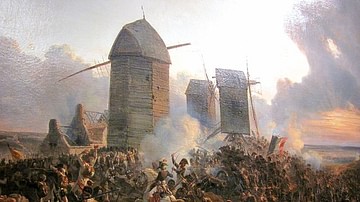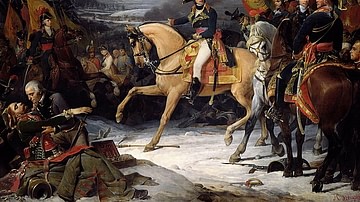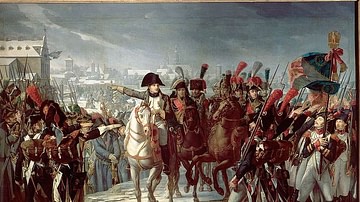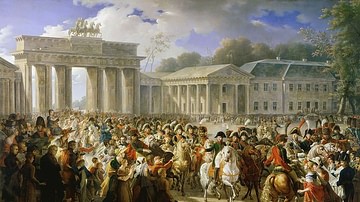The Battle of Tourcoing (17-18 May 1794) was a major engagement in the War of the First Coalition, the first phase of the French Revolutionary Wars (1792-1802). It saw an army of the French Republic successfully fend off a six-pronged attack by Coalition forces; victory at Tourcoing would lead to French success in the broader Flanders Campaign of 1792-95.

Despite the superior quality of their soldiers, the Allied plan of attack failed because of its over-elaborateness; it required six columns to cover a large amount of ground in the sweltering summer heat, with minimal communication with one another. The French Army of the North, commanded by Joseph Souham, was able to strike and overwhelm two of the Allied columns and thereby negate the Allied plan of attack.
The defeat disheartened the Allied troops, especially as Austria, the senior partner in the Coalition, became more interested in affairs in Poland. Therefore, Tourcoing laid the groundwork for the French victory at the decisive Battle of Fleurus (26 June 1794), after which the French remained ascendant for the remainder of the war.
Background
The opening of the 1794 campaign season saw the War of the First Coalition enter its third year. What had initially been billed as a short conflict to rid Europe of the pesky French Revolution (1789-1799) had turned into a protracted affair; not only had the resolve of the French military been stiffer than expected but the Allied invasion had also lost its initial momentum. After winning a decisive victory at the Battle of Neerwinden in March 1793, the Allied army pushed into France; but rather than advancing directly to Paris, it decided instead to besiege the French fortified cities on the frontier. This strategy was devised by the Allied commander-in-chief, Prince Josias of Saxe-Coburg-Saalfeld. A naturally cautious man, Coburg sought to secure for his army a base of operations on French soil before risking a march on Paris.
Coburg's delay allowed the French valuable time to reorganize their military. Supplies and equipment were diverted to the armies, and the levée en masse of August 1793 decreed that all unmarried men between the ages of 18-25 be available for conscription. These reforms allowed the French to win three successive victories over the Allies at the end of the 1793 campaign season: the Anglo-Hanoverians were defeated at the Battle of Hondschoote (6-8 September), the Dutch were defeated at Menin (12-13 September), and the Austrians were beaten at the Battle of Wattignies (15-16 October). After Wattignies, the armies of both sides settled into winter quarters, allowing the infant French Republic to survive for another winter.
The Armies
Both the French and Allied armies experienced changes of command in the early months of 1794. On 8 February, General Jean-Charles Pichegru took charge of the French Army of the North and the Army of the Ardennes, which included a combined total of 227,000 men. This was an enormous command for even the most competent of generals, of which Pichegru decidedly was not, having had mediocre success in his previous commands in the Rhineland. Yet the talent of Pichegru's subordinates would see the French army through the coming months. Despite outnumbering the Allies numerically and enjoying easier access to supplies, the French army consisted overwhelmingly of undisciplined, untrained conscripts. Pichegru arrived under orders from Paris to envelop the Allies' flanks and drive them back into the Austrian Netherlands (Belgium).
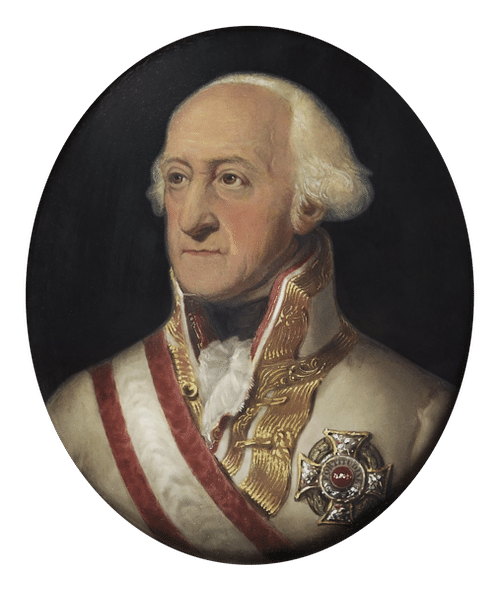
In late March, the Coalition army also received a new commander. Francis II, Holy Roman Emperor, arrived to take personal command at the request of his younger brother, Archduke Charles. This was done both to inspire the troops and to reassert the dominance of Austria among the nations of the Coalition, which were distrustful of one another. When the emperor arrived, the army consisted of some 130,000 battle-ready soldiers. The bulk of these troops were from Austria, although there were also significant numbers of soldiers from Great Britain, Prussia, the Dutch Republic, Hanover, and several other German states. Francis II's command was only nominal, and he left the decision-making to Coburg and his chief of staff, Karl Mack von Leiberich. With the emperor's approval, Coburg decided to resume his strategy of fortress-hopping and set his sights on the city of Landrecies.
Opening Operations
The campaign season began on 29 March, when Pichegru launched a failed attack on the Allied lines at Le Cateau. Three weeks later, the Allies began their own offensive and advanced to Lendrecies, which was promptly put under siege on 17 April. The siege was conducted by the Hereditary Prince of Orange, while the rest of the Allied army covered the operation in a semicircle. Pichegru, under immense pressure, decided to attack both Allied flanks while sending relief to Landrecies itself. The main French attack was beaten off at the Battle of Beaumont on 26 April, and Landrecies fell to the Allies four days later.
With the fall of Landrecies, Coburg, and Mack decided to focus their efforts on taking Maubeuge, the last of the significant frontier fortresses; should Maubeuge fall, the Allies could finally contemplate an invasion of the French interior. The French understood the severity of the situation, and on 28 April, Pichegru began his counteroffensive. On 28-29 April, the French army under Pichegru and General Joseph Souham defeated an Allied force under Count Clerfayt at the Battle of Mouscron; Clerfayt was wounded in the fighting, and the Allies lost 3,000 prisoners, 33 cannons, and 4 colors. The French pushed on to recapture Menin and Courtrai, although they were slightly hindered by the British at Willems (10 May). Pichegru's successful counterattack convinced the Allies to adjust their plans; what they came up with was one of the most overambitious plans of the entire war.
Annihilation Plan
The Allied plan of attack, given the grandiose name of the Vernichtungsplan (annihilation plan), is often attributed to the Austrian chief of staff, Mack von Leiberich. Its stated intention was to "act upon the enemy's communications between Lille, Menin, and Courtrai, and to defeat his armies…and to drive him out of Flanders" (Brown, 160). In essence, Mack hoped that an Allied victory could allow for the completion of their occupation of Flanders so that the Allies could push on to Paris and end the war.

The plan was to overwhelm and envelop the French army between the Lys River to the north and the Scheldt to the east. Mack had 73,000 men and decided to split them up into five columns and a covering force, each with its own stated objective:
- 1st Column: 4,000 Hanoverians under Georg Wilhelm von dem Bussche to march from Espierres by Dottignies. Objective: Mouscron.
- 2nd Column: 10,000 Austrians under Rudolf von Otto to march from Bailleul. Objective: Tourcoing.
- 3rd Column: 11,000 British, Hanoverians, and Austrians under Duke Frederick Augustus of York and Albany, to march from Templeuve. Objective: Roubaix.
- 4th Column: 11,000 Austrians under Count Kinsky to march to Bouvines. Objective: west bank of the River Marque.
- 5th Column: 18,000 Austrians under Archduke Charles to march from St. Armand. Objective: west bank of the River Marque.
- Covering force: 19,000 Austrians under Count Clerfayt to advance from Thielt in the north, to cross the River Lys at Wervicq. Objective: Linselles.
There were, of course, problems with this plan. The ground it required to be covered was unlike anything seen in 18th-century warfare and was on a scale more closely resembling the operations of World War I (1914-18). Historian Stephen Brown notes how the battlefield of Waterloo could fit inside the operational area of the Battle of Tourcoing 75 times, and the battlefield of Austerlitz 20 times (Brown, 162). Furthermore, when the plan was hatched on 16 May, not all of the Allied contingents were where they needed to be; Archduke Charles was still at Landrecies, c. 95 km (60 mi) away, and would not even receive word of the plan until after dawn on 17 May, the day the plan was to commence. Despite these difficulties, the Allied plan went ahead: at daybreak on 17 May, each of the six groups prepared to march.
First Day: 17 May
The Allies' carefully laid plans fell apart almost immediately. Count Clerfayt got a late start and did not arrive at his objective, the bridge at Wervicq, until mid-afternoon. Here, he encountered a French battalion that had been on its way to Menin. This was a stroke of bad luck; had Clerfayt arrived half an hour sooner or later, the bridge would have been undefended. Unwilling to force a crossing, Clerfayt hesitated until the French cleared off at nightfall, at which point he crept across the river. By the time he was in position, he was almost a full 24 hours behind schedule.

Meanwhile, General Bussche's 1st column was able to drive the French out of the town of Mouscron; however, it was not long before Bussche was pushed out by a fierce French counterattack, forcing him to give up the town and withdraw. General Otto's 2nd column fared better, seizing its own objective, the town of Tourcoing, with relative ease. Yet Otto, who was supposed to be covering the Duke of York's 3rd column, moved quicker than expected and neglected to inform the duke about his good progress. As a result, by the time York reached his own objective of Roubaix, he felt exposed; he was aware that Bussche's attack on Mouscron had failed, and had received no word at all from Otto. York wrote to the emperor, asking to be allowed to remain in Roubaix until the 4th and 5th columns had caught up with him. He received a letter from Mack in response, urging him on to the town of Mouveaux. Hesitantly, York complied, though he felt no less wary upon reaching Mouveaux; he made another request to withdraw to a more secure location, but this was again denied.
The 4th and 5th columns, which were supposed to have met at the west bank of the Marque river, had also run into problems. Kinsky's 4th column had begun to march at daybreak but had stopped at 7 a.m. to allow the thick mists that covered the fields some time to dissipate. When Kinsky reached the river by way of Bouvines, he found that the bridge had been destroyed and that the French had covered the crossing with a battery of heavy guns. Kinsky refused to force a crossing until he was reinforced by Archduke Charles and waited at Bouvines, engaging the enemy in sporadic skirmishing. The archduke's exhausted troops would not arrive, however; they had been marching in the sweltering heat for 24 hours and were too tired to make it any further than Lesquin. Still, Charles' advance troops helped Kinsky drive off the French. Kinsky then repaired the bridge at Bouvines, though he still refused to cross without reinforcements. By the end of the first day, therefore, only two of the six columns (Otto and York) were where they needed to be.
French Response
The French were taken by surprise by the Allied movement. As reports filtered into the French headquarters at Menin throughout the day of 17 May, the sheer scale of the operation became apparent. General Pichegru was away, so command of the French army fell to one of his subordinates, General Souham. Described by historian Ramsay Weston Phipps as a "tall, stuttering general", Souham had only achieved the rank of general the previous summer and was now responsible for the survival of an entire army. Yet he wasted no time devising a counterattack: a division under Jean Moreau was to check Clerfayt's advance to the north, while Souham himself and General Jacques-Philippe Bonneau (also given as Bonnaud) would lead 40,000 men against the Allied center (Otto's and York's columns). The garrisons at Lille and Douai, meanwhile, were to sally forth to detain the Allied detachments along the Marque (Kinsky and Charles). Upon hearing this plan, General Moreau remarked:
It would require a piece of good fortune, on which we cannot count, to prevent half of my division and myself from being sacrificed according to this plan, but still it is the best which can be proposed and…should be adopted. (Phipps, 300)
Second Day: 18 May
The early morning hours of 18 May were filled with confusion at the Allied headquarters. They knew that Bussche had failed to take Mouscron, that Archduke Charles was not in position, had received multiple letters from York asking to withdraw, and had heard nothing at all from Clerfayt. At 1 a.m., Mack reassured York that help was coming and dispatched a courier to Archduke Charles, to urge him to advance to Lannoy and cover York's flank. The courier arrived at Charles' headquarters at 4 a.m., only to find that the archduke was suffering from an epilepsy attack and could not receive him. Mack sent fresh orders at 3 a.m., telling Kinsky and Charles to march to Lannoy, and ordering Otto and York to prepare an attack on Mouscron at noon.
Meanwhile, the French were moving into attack positions of their own. To the north, Clerfayt crossed the Lys before encountering a French brigade under General Vandamme. Thanks to the actions of the British 8th Dragoons, Clerfayt initially seized the upper hand, and turned Vandamme's right flank; however, the French soon rallied and pushed Clerfayt back. Clerfayt, falsely believing the French had been reinforced, pulled back to Wervicq to await instructions and played no further role in the day's actions. With Clerfayt successfully detained, the French could attack the other Allied columns without worrying about being flanked. Under the cover of predawn darkness, Bonneau had formed up his men outside the town of Tourcoing; at first light, the French attacked, taking Otto's column completely by surprise.

Outnumbered and overwhelmed, Otto wrote to the Duke of York for help. York sent two infantry battalions, but by the time they arrived, Tourcoing was in French hands and Otto had been driven back. By 7 a.m., York's own column came under attack by Bonneau's men at Roubaix and Lannoy, with further French detachments striking the British at Mouvaux. Bonneau's men were able to slip through the gap in the Allied lines left by the two battalions York had sent to aid Otto, allowing the French to surround and isolate the Allied units. York's men had no choice but to fight their way out of this encirclement and retreat, and York himself narrowly avoided capture. The French fired volleys into the confused English troops, ambushing artillery and supply trains and capturing 56 guns. In the chaos, not even the English camp followers were spared from French musket and artillery fire. One eyewitness, Cornet Robert Wilson, describes a haunting scene:
I saw a soldier's wife take a baby from her breast and, giving it a kiss, fling it into the stream or ditch, when she frantically rushed forwards and, before she had got ten yards, was rent in pieces by a discharge of grapeshot that entered her back, sounding like a sack of coals being emptied. (Phipps, 306)
Upon driving back Otto and York, the French did not risk a pursuit, as Clerfayt's presence to the north still presented a threat. By afternoon, only the columns of Kinsky and Archduke Charles remained on the field; yet Kinsky, ignoring orders to press onward and capture Sainghin, stalled. At 2 p.m., when word reached him of the defeat of Otto and York, Kinsky withdrew. The archduke, meanwhile, was attempting to obey his orders to move to Lannoy, but his weary troops got off to a late start and did not begin to march until noon. At 3 p.m., Charles received orders to fall back to the Allied headquarters at Tournai. Although Archduke Charles would later prove to be one of Austria's best generals, he and Kinsky contributed nothing to the Battle of Tourcoing; as Phipps put it, their two columns "might as well have been a hundred miles away" (302).

Aftermath
The Battle of Tourcoing was a resounding French victory. The Allies lost around 4,000 men killed or wounded, with another 1,500 taken prisoner. The French lost around 3,000 casualties. Although he had played no part in the battle, General Pichegru took full credit for the victory that had actually belonged to Souham and Bonneau. Hoping to capitalize on the momentum, Pichegru ordered the army forward to engage the Allies at their headquarters of Tournai. The Battle of Tournai, or the Battle of Pont-à-Chin (22 May) resulted in a French defeat, though it did not nullify the gains made at Tourcoing.
The Allies became disheartened by their defeat at Tourcoing, and their morale only worsened on 30 May, when Emperor Francis II returned to Vienna, taking Mack with him. The emperor was more concerned with events in eastern Europe, where the great powers of Russia and Prussia were preparing a Third Partition of Poland; unwilling to be excluded, Francis II began siphoning off officers and soldiers from Coburg's army for redeployment in the east. The loss of Allied morale and support from Vienna following the Battle of Tourcoing, therefore, was a significant moment in the war. The groundwork was lain for the French victory at the Battle of Fleurus a little over a month later, which was arguably the most decisive battle of the entire war; after their victory at Fleurus, the French were consistently victorious until the War of the First Coalition ended in 1797.




